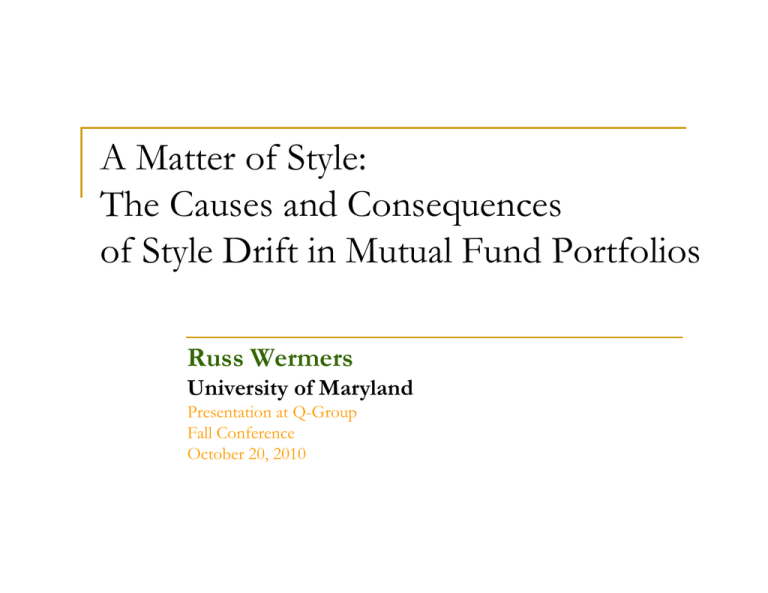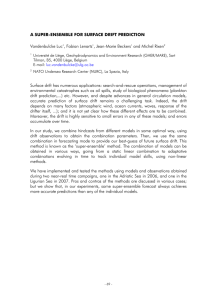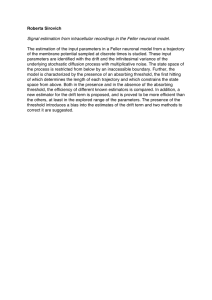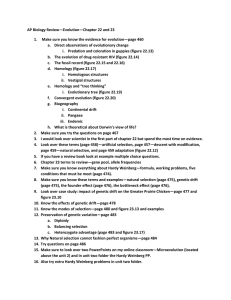A Matter of Style: The Causes and Consequences Russ Wermers
advertisement

A Matter of Style: The Causes and Consequences of Style Drift in Mutual Fund Portfolios Russ Wermers University of Maryland Presentation at Q-Group Fall Conference October 20, 2010 Style Investing is a Common Approach to the Portfolio Allocation Problem Investors, especially institutional, categorize stocks and funds into: Small cap vs. large cap Growth vs. value Technology vs. stable Momentum vs. contrarian … and other style categories March 11, 2011 2 However, Little is Known About the Dynamics of this Approach Some interesting issues include: Does style specialization improve performance? Do institutions actively control their style drift? Should we constrain active managers to stick to their “style box”? My paper investigates these issues March 11, 2011 3 Academic Studies on Style Investing Grinblatt, Titman, and Wermers (1995) Find evidence of active momentum as a common style of mutual funds Carhart (1997) Funds buy winners and (to a lesser degree) sell losers Mutual funds experience momentum by good luck, then ride the momentum the following year After controlling for momentum, no alpha Chen, Jegadeesh, and Wermers (2000) March 11, 2011 The mutual fund industry has a preference for liquid, growth, and momentum stocks 4 My Contributions 1. What types of funds experience style drift? Smallest cap funds have almost twice the style drift of largest cap funds But, even large cap funds exhibit significant style drift Growth funds exhibit slightly higher style drift than value funds 2. What is the trend in style drift? An initial increase in style drift following 1975 removal of fixed trading costs Significant decline since mid-1980s, even though trading costs have decreased substantially March 11, 2011 5 My Contributions 3. Does style drift help or hurt performance? Funds with more “active style drift” (style drift through trading) have significantly higher alphas 4. Do funds aggressively control style drift? The average fund manager does not seem overly concerned with style drift More concern with drift over time, however March 11, 2011 Influence of the Morningstar Style Boxes? 6 Opposing Views on Style Drift Style drift should be controlled tightly Specialization of skills Risk management/portfolio diversification Style drift should not be controlled Specialization is not style specific Industry or strategy, not style Contrained optimization always produces less favorable outcomes March 11, 2011 7 Brief History of Style Investing Prior to the 1990s, many more “balanced” funds Asset allocation and sector allocation decisions handled by the manager Morningstar introduced “Style Box” in 1992 “…to help investors and advisors determine the investment style of a fund.” March 11, 2011 “Different investment styles often have different levels of risk and lead to differences in returns. Therefore, it is crucial that investors understand style and have a tool to measure their style exposure.” 8 Style Investing Today Most mutual fund managers have a style specialization SEC requires that 80% of securities in portfolio must be consistent with fund name Many funds use a “style word” in their names, e.g., “Legg-Mason Value Trust,” “Fidelity Aggressive Growth,” “PIMCO Small Cap StocksPLUS” March 11, 2011 9 Potential Purposes of Style Investing Simple marketing gimmick Appeals to investors who need organizing principles Risk control Need to understand how investment “pieces” fit together Barberis and Shleifer (JFE, 2003) model “style investors” Appears to be Morningstar’s original intent Commitment device March 11, 2011 Manager signals true skills within a style specialization Fund prospectuses seem focused on this purpose! 10 Methodology March 11, 2011 11 Style Classification Based on Stock Characteristics (DGTW (1997)) Non-covariance based matching—matching based on characteristics, not based on factor loadings derived from regressions Sharpe (1992) moving regressions are excellent, when only returns are available! We form quintiles of CRSP stocks based on (1) size, (2) book-to-market, and (3) prior-year return 125 value-weighted control portfolios (5x5x5) March 11, 2011 12 Analyzing Style Drift Rank all NYSE stocks by Mkt. Cap. Divide into 5 Quintiles Rank Quintiles = Book Value/Market Value (BTM) Subdivide into 5 more quintiles Rank the 25 fractiles by past year stock return Subdivide into 5 more quintile A rank of: Size=5, BTM=5, PR1YR=5 Large Cap High BTM High Past Return March 11, 2011 13 RANK ALL STOCKS NYSE - CRSP DATA = Capitalization Size 12 34 5 1 = Smallest Cap 5 = Largest Cap X Book To Market BTM 12 34 5 1 = Lowest BTM 5 = Highest BTM SIZE BTM POSSIBLE RANKINGS = ( 5 x 5 March 11, 2011 X PR1YR RETURN 12 34 5 1 = Lowest RTN 5 = Highest RTN PR1YR x 5 ) = 125 14 Measuring Style Drift What are the sources of style drift? 1. Stock-level drift 2. Portfolio-weight drift 3. Active trading drift Important to separate “passive style drift” from “active style drift” March 11, 2011 15 Measuring Style Drift Total Style Drift (TSD) in style dimension l = stock j portfolio weight at end-ofquarter t = stock j characteristic at end-of-quarter t in style dimension l March 11, 2011 16 Total Style Drift Decomposition Passive Style Drift (PSD)—change in style during quarter t assuming buy-and-hold: Active Style Drift (ASD)—change in style due to actual portfolio, relative to buy-and-hold portfolio: March 11, 2011 17 Averaging TSD Across “M” Funds By triangle inequality, Note that [ ]- Large for “Style Constant” fund ( Small for “Style Chasing” fund March 11, 2011 0) : = 0) = 18 Measuring Performance Impact Return due to Passive Style Drift Return due to Active Style Drift March 11, 2011 19 Data Thomson quarterly mutual fund holdings U.S. domestic equity 1975 to 2006 Matched with fund returns and characteristics (TNA, expenses, etc.) using MFLINKS (available at Wharton WRDS) Matched with manager characteristics (experience, track-record) using Morningstar, Wiesenberger, etc. March 11, 2011 20 Results March 11, 2011 21 A 31-Year Look at Style Drift Size Dimension 0.3 0.25 0.2 0.15 PSD (Size) ASD (Size) TSD (Size) 0.1 0.05 0 March 11, 2011 22 A 31-Year Look at Style Drift BTM Dimension 0.35 0.3 0.25 0.2 PSD (BTM) 0.15 ASD (BTM) TSD (BTM) 0.1 0.05 0 March 11, 2011 23 March 11, 2011 2006 2005 2004 2003 2002 2001 2000 1999 1998 1997 1996 1995 1994 1993 1992 1991 1990 1989 1988 1987 1986 1985 1984 1983 1982 1981 1980 1979 1978 1977 1976 A 31-Year Look at Style Drift Momentum Dimension 1.2 1 0.8 0.6 PSD (Momentum) ASD (Momentum) TSD (Momentum) 0.4 0.2 0 24 Table 3: Fund Characteristics and Style Drift Growth Funds, averaged over all years: March 11, 2011 25 Table 3: Fund Characteristics and Style Drift Value Funds, averaged over all years: March 11, 2011 26 Table 4: Characteristics of Funds and Managers with High vs. Low Active Style Drift (ASD) March 11, 2011 27 Table 5: Performance Implications of High vs. Low Active Style Drift (ASD) (Funds ranked on 3-year past ASD) Following-year portfolio-level alpha March 11, 2011 28 Interpretation More aggressive managers of smaller funds with good track-record have highest ASD Higher ASD leads to significantly higher precost alphas Expense ratios and trade cost estimates indicate that some of this alpha would survive costs March 11, 2011 29 Direct Return Effect of Style Drift (Style timing using PSDR and ASDR, %/quarter) March 11, 2011 30 Summary of Findings Paper develops new holdings-based methodology to measure Active style drift is declining over time (“closet indexers”?) Style drift higher for growth funds, small funds Active style drift (ASD) Passive style drift (PSD) Active style drift returns (ASDR) Passive style drift returns (PSDR) Do large funds get “style boxed-in”? Style drift higher for successful managers, both past and future March 11, 2011 31 Future Work Compare/contrast holdings-based style measurement (HBSM) with returns-measured style measurement (RBSM) How precise is RBSM, relative to HBSM? How to combine the two methods to extract maximum information on style and style drift? March 11, 2011 32




